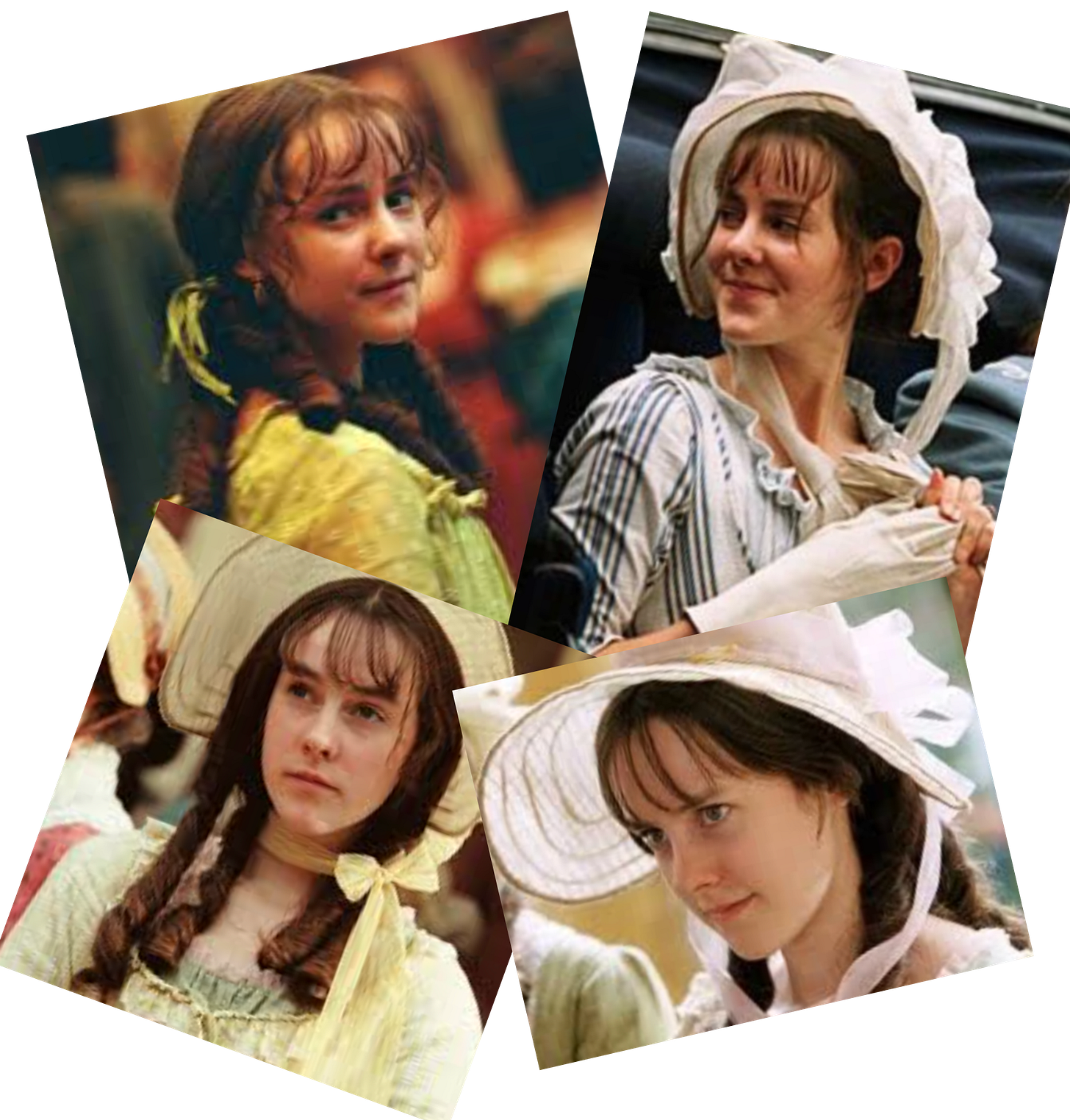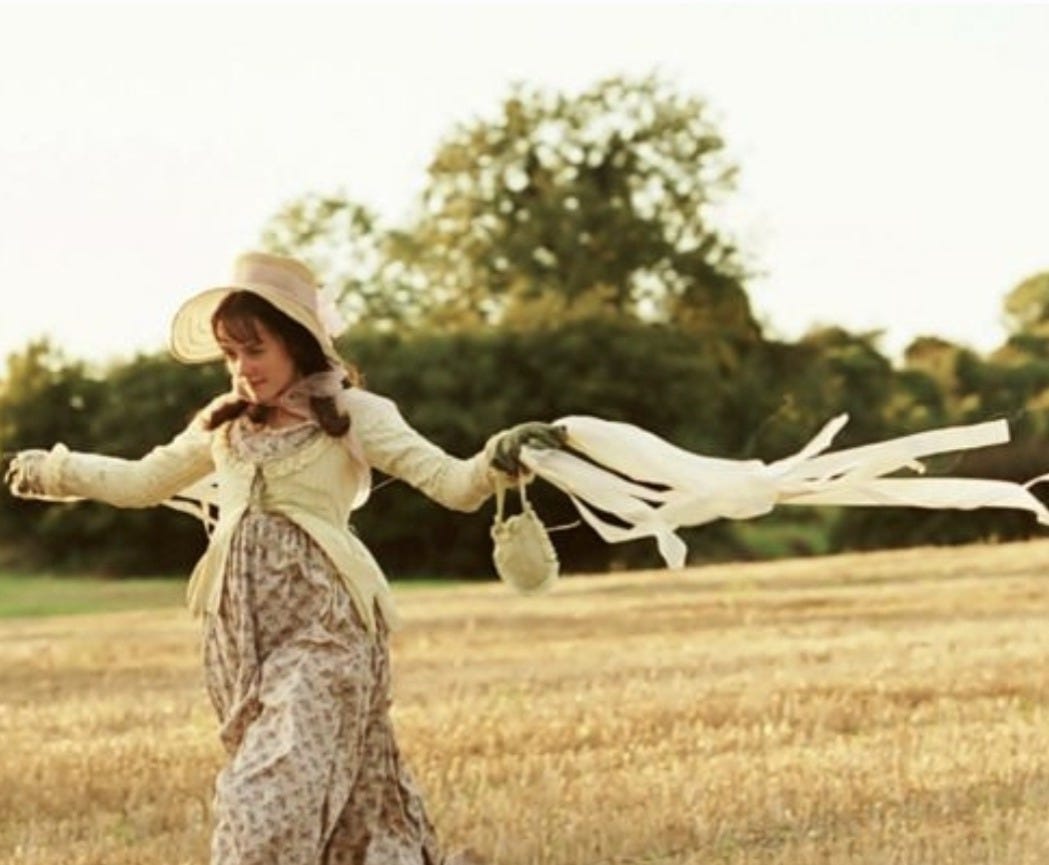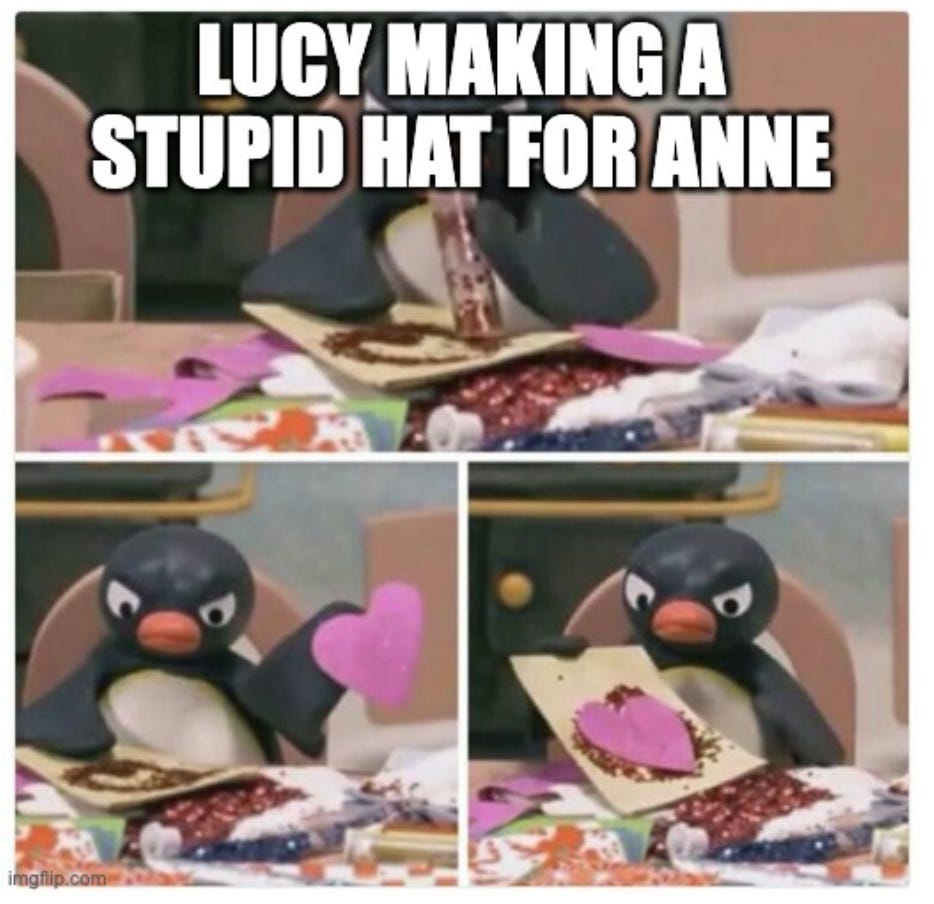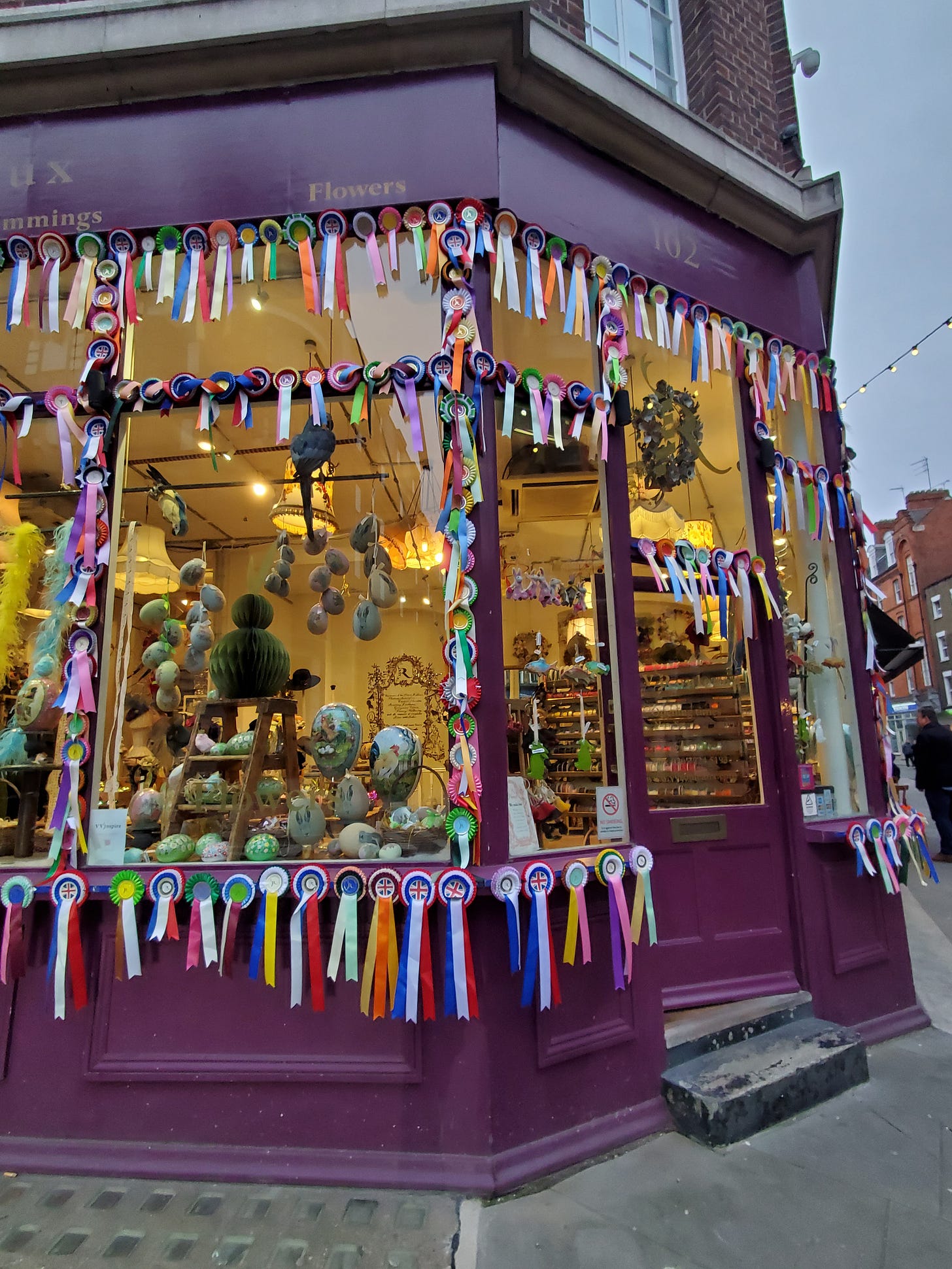Can't spell 'matrimony' without 'trim' in Jane Austen's works
On the use of ribbons in her novels, where a 'silly' accessory symbolizes social mobility
When things feel extra doom-y, I putter and organize my hobby slop. The few things that survived my recent clean-out were my hair accessory supplies — ribbons, headbands, clips, and a quantity of faux flowers that is, frankly, concerning to family members.
To say that I love hair accessories is an understatement. I’ve mentioned before my fondness for weird hats. I once told a friend during the bleak pandemic days that the only thing getting me out of bed was the mere existence of headbands, and being able to make them.1 I’m currently making hair bows because they don’t require a lot of energy, and I have enough velvet ribbon to open my own millinery. Some reptilian part of my brain knows that when the going gets tough, I will have a glue gun in my hands.2
I am totally risking alienating ALL of you with this very niche interest of mine, but the rise of ‘coquettecore’ has seen a recent resurgence in all things frippery: see exhibits 1, 2, 3. And while it’s hardly a new practice, ribbon usage in clothing has seen renewed interest — from modern indigenous practices to the Prada runway. And the humble hair bow has even been politicized as both a win and a loss for feminism.
Whenever I’m high off my craft supply, I sometimes think about the use of these same accessories in Jane Austen’s works. To borrow some thinking from the Cerulean Speech,™ it might look like a pile of stuff. It might look silly, but I’d argue things that are of interest primarily to women are often disregarded as such.3
On ribbons and social mobility in Austen’s works
But ribbon is never really about ribbon in Pride & Prejudice – it symbolizes social mobility. The way you trim your cap could have consequences for your standing.
Austen herself was occupied with the latest in Regency accessories, Hilary Davidson writes in Jane Austen’s Wardrobe, which chronicles (among other sartorial items) the many bonnets, caps, and hats that Austen wrote about in her letters. Noting a passage on a straw bonnet “trimmed with white ribbon,” Davidson observes:
“Looking ‘very much like other people’ was clearly a concern; to be sitting in the comfortable gentry middle ground of being neither too forward nor too behind in the fashion stakes.”
In Austen’s works, a conversation about ribbons4 often is a lead-in to the social chess women were forced to play. The haberdashery shop is the stage for intel. If marriage is an economic proposition, as Amy March posits in Greta Gerwig’s 2019 Little Women movie, seemingly trivial fashion choices are tools to navigate that proposition. It’s also a way for women to exercise autonomy in a world where they have few options.
Pride & Prejudice:
Consider this line early on from Pride & Prejudice, when Mr. Bennet watches our heroine, Elizabeth:
“Observing his second daughter employed in trimming a hat, he suddenly addressed her with, “I hope Mr. Bingley will like it, Lizzy.”
He might not be flush with the dowry funds, but Papa Bennet doesn’t miss.

Later in Meryton, the younger Bennet daughters, Kitty and Lydia, are living the Sex and the City movie ethos of labels or love:
“Their eyes were immediately wandering up in the street in quest of the officers, and nothing less than a very smart bonnet indeed, or a really new muslin in a shop window, could recal them.”
Lydia, the youngest of the five Bennet daughters, especially comes off as a frothy flirt. But she’s brimming (ha) with excitement to become a consumer of things that might land her a husband. It’s what she’s been taught.

She tells her sisters:
“I am glad I bought my bonnet, if it is only for the fun of having another bandbox! Well, now let us be quite comfortable and snug, and talk and laugh all the way home. And in the first place, let us hear what has happened to you all, since you went away. Have you seen any pleasant men? Have you had any flirting?”
The 2005 movie is more explicit in its use of ribbons as a flirtation device. Lydia meets her future husband, the cad George Wickham, when he buys her ribbons and flirts with her older sister, Elizabeth. Wickham is later revealed as a dirtbag who wreaked havoc and heartbreak on the Darcy household. The ribbons in this case are representative of Lydia’s girlish naiveté and recklessness in getting involved with him.5
Finally, the 2005 movie gives us this quick gesture of Mr. Bingley quietly reaching for Jane’s ribbons during the Netherfield ball. He is down bad:
It’s not the hand flex, and it’s not “you’ve bewitched me, body and soul” but dammit if it’s not a detail that supports this frippery = social mobility thesis I’ve got going.
Emma:
In Emma, we see the use of ribbons to solidify social standing. Note how our protagonist, the wealthy Emma Woodhouse, is so bored when her companion Harriet goes back and forth on what to buy at the local haberdashery store Ford’s:
“Emma watched them in, and then joined Harriet at the interesting counter, trying, with all the force of her own mind, to convince her that if she wanted plain muslin it was of no use to look at figured; and that a blue ribbon, be it ever so beautiful, would still never match her yellow pattern.”
Harriet has less money, so every purchase is fraught and she has to — to quote my favorite poker player — make it count. But to Emma, the bigger priority is to have the decency to make it all match.

Emma soon finds herself stuck in a conversation with Miss Bates, a poor-but-sweet chatterbox whose niece Jane Fairfax is a romantic rival to Emma. Miss Bates begins her intel on Jane while getting distracted by ribbons:
“How do you do, Mrs. Ford? I beg your pardon. I did not see you before. I hear you have a charming collection of new ribbons from town. Jane came back delighted yesterday. Thank ye, the gloves do very well—only a little too large about the wrist; but Jane is taking them in.”
Miss Bates’s undiagnosed ADHD is absolutely played for laughs in this scene, but she serves up monumental goss. Emma, stunted for excitement, gets some details on a potential beau, Frank Churchill.
Later, we see the snobby tryhard Mrs. Elton insult Jane and attempt to steamroll Mr. Knightley’s picnic, all while laying out her OOTD plans:
“That’s quite unnecessary; I see Jane every day —but as you like. It is to be a morning scheme, you know, Knightley; quite a simple thing. I shall wear a large bonnet, and bring one of my little baskets hanging on my arm. Here,—probably this basket with pink ribbon.“
She thinks she can be the social dom because she’s recently married, and therefore one of their betters.

Other novels:

In Austen’s other works, ribbons aren’t mentioned as frequently. But when they are, they are often mentioned in the same breath as news about an engagement, or the plotting to land one.
In Sense & Sensibility, ribbon is used as a stand-in for mental stability. Our protagonist Elinor Dashwood gets this rambling preamble on her romantic rival, Lucy:
“[Anne Steele]: “Good gracious! I have had such a time of it! I never saw Lucy in such a rage in my life. She vowed at first she would never trim me up a new bonnet, nor do any thing else for me again, so long as she lived; but now she is quite come to, and we are as good friends as ever. Look, she made me this bow to my hat, and put in the feather last night. There now, you are going to laugh at me too. But why should not I wear pink ribbons? I do not care if it is the Doctor’s favourite colour.”
These missives about ribbons give a hint of status-seeking Lucy’s mental state. She’s pissed that Edward’s disinheritance means they will have to live on love alone (horror of horrors!), but the girl can sloppily over-accessorize a hat when needed. For Elinor, this is a prelude to crushing news: despite all the drama, Edward will do the honorable thing and burn Lucy’s ugly hats keep his engagement with Lucy. 6
In Mansfield Park, Fanny Price debates getting dressed for a ball and wonders how she can stand out from the other women. She worries that wearing a cross with a ribbon7 is going to signal she’s too poor:
“… [A]nd the almost solitary ornament in her possession, a very pretty amber cross which William had brought her from Sicily, was the greatest distress of all, for she had nothing but a bit of ribbon to fasten it to; and though she had worn it in that manner once, would it be allowable at such a time in the midst of all the rich ornaments which she supposed all the other young ladies would appear in? And yet not to wear it!”
Finally, in Persuasion, ribbons are mentioned while showing disdain with a former pursuit. Consider the self-absorbed Elizabeth Elliot being absolutely done with her cousin William, who she previously wanted to marry:
“Yet so miserably had he conducted himself, that though she was at this present time (the summer of 1814) wearing black ribbons for his wife, she could not admit him to be worth thinking of again.”
Some beaus (especially the fuckboy variety) aren’t worth the yardage.
Ok you’ve made it this far, so I’ll just end on my platonic ideal of a building: VV Rouleaux in London, which is basically the modern-day equivalent of the Ford’s haberdashery store in Emma. I took this photo in March 2024, and promptly bought a headband (covered in velvet ribbon, of course).
Extended reading:
Emma is worth seeing for the hats | The Cut
A ribbon dyer reflects on the movie Emma | Lancaster & Cornish
An interview with the costume designer of Emma | EW
The importance of a good hat: Individuality in millinery | The Met
Confessions of a ribbon fanatic | Financial Times
How artificial flowers became cool | House & Garden
A brief history of the hair ribbon | The Courtauld
Accessories and the Austen sisters | JASNA
Loose Buttons posts you might enjoy:
What do we wear to the revolution?
Fashion inspiration from the Rococo era
The foreshadowing of Ingrid Bergman’s clothes in Casablanca
The Bloomsbury Group’s influence on fashion and interiors
In all seriousness, seeing a fridge truck pull up on my avenue to cart bodies away had a way of aligning my priorities (as small as they might seem).
Jury’s out on whether Betsy Ross and I would even vibe today, but I think I understand the impulse to create a lil’ flag while there’s a revolution going on.
It should be noted that English menswear during the Regency era was influenced by plainer riding styles that began in the 18th century and flourished after the French Revolution. Men became less likely to wear color or adornment. Read more about those changes here.
From here on out, when I say ribbons, it is a stand-in for all the trimming, notions, decorations, etc that might be on hats and clothing in the Regency period.
When you think about it, she is kind of a tragic figure — failed by her family (for prizing marriage above all else), and preyed on by Wickham.
Don’t worry, everyone ends up with who they deserve by the end.
A cross pendant on a ribbon feels very 90s Buffy meets The Craft goth and I’m into it.









I love your love of hair ribbons and bows and hats. <3